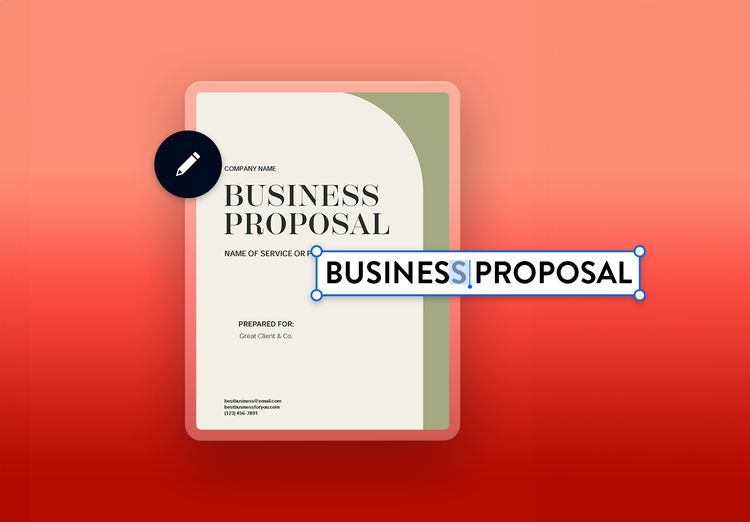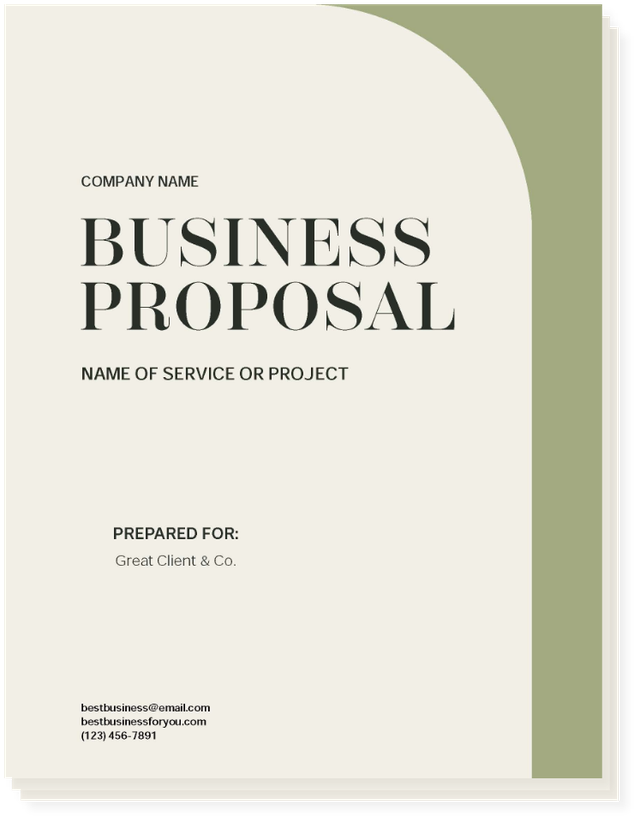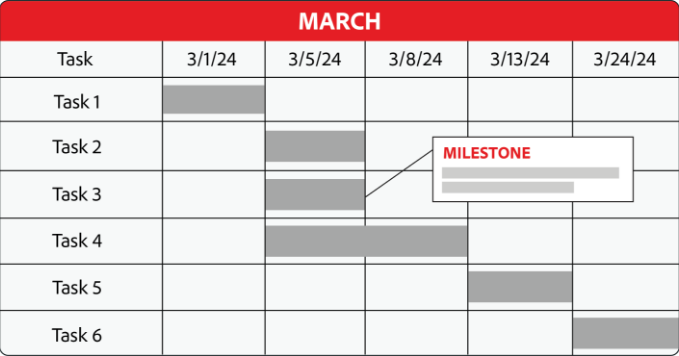Acrobat for business | 10-Minute read
Business proposal template: how to write a proposal in 7 steps.
Create a well-structured proposal to win new clients and business.
Acrobat for business | 10-Minute read
Create a well-structured proposal to win new clients and business.

A business proposal is a written offer of a product or service most commonly sent to prospective customers. Moreover, they can also be presented to existing customers, such as when a company tries to upsell an additional product or service.
How your proposal is written can be the difference between winning or losing a client. A poorly designed proposal overcomplicates the solution, excludes customer details and needs, disregards grammar and style, and prevents you from advancing your company’s goals.
A good proposal should always answer these key questions:
Answering these questions sets expectations upfront for the customer and holds a business accountable for its outlined products and services.
Business proposals can vary in formatting, but all should have the essential elements: title page, table of contents, details on your company’s why in the executive summary, a problem or need statement, a proposed solution, qualifications, a timeline, pricing, billing, legal information, clarification of terms and conditions, and the acceptance section where your potential buyer can sign the document.
Before composing your proposal, ensure that you have a comprehensive understanding of a business proposal template. If you need additional details, consider setting up an initial meeting or phone call to gain insight into what the client wants from a prospective vendor. If the business has shared an RFP with you, thoroughly review the document. After your research is complete, you can create your business proposal. The key steps to begin writing the proposal are detailed below.

Building a business proposal is a highly structured process, which means that an outline is essential. Before creating your outline, ensure you have completed your research and are well prepared and informed about your client. You likely know what you want to do to expand your business already — make sure you have case studies, pertinent data, and compelling examples of how your proposal will benefit your client.
While learning about your client, you may discover graphics, images, or other details you want to document for your research. Consider a tool such as a free scanner app that lets you scan any content item into a PDF and incorporate them into your proposal outline.
When you are ready to create your outline, note that the process can be as simple as making a one-or two-page document, with bullet points breaking key areas into quick summaries that you can expand into sections. You can use steps 2–6 here as the framework for your outline. You can even build out the entire document in a PDF editor, where you can drop pages and add PDF comments to your proposal on the fly.
The title — the introduction to your proposal — is the first step in getting eyes on your work. Especially if the proposal is unsolicited, you must excite your audience and assure them that your solution will solve their pain points. Creating a strong, solid titlepage gives a prospective client an idea of the value proposition and the information contained within the proposal.
A good title includes a good tagline. A tagline represents your company’s values — it doesn’t represent an individual product. The tagline must be short enough to catch your reader’s attention but long enough to represent what your business has to offer. Focus on positive words and use simple terminology. Consider these examples in response toa website redesign proposal:
Poor taglines
Good taglines
From sales proposals to marketing proposals, the table of contents provides clues to your audience about what you’re selling and how it benefits them. It is also a significant part of your proposal since most of your readers will be C-level executives who will most likely scan through it. The table of contents not only helps readers reference where different sections start and end, but it can also provide additional small summaries of each section — the options are up to you.
The executive summary functions as an introduction to your reader. In some ways, it’s like a 1–2 page cover letter — a concise introduction and summary of your proposal.
A good executive summary will:
You’re talking to decision makers and potential customers, so make sure your writing is snappy with an optimistic, confident tone and reels your audience in as much as possible. If you’ve previously worked with well-known and respected companies, include their names within the summary to help highlight your achievements. To complete your summary, clearly define what your audience can expect in the following sections of the proposal.
Problem, solution, qualifications — these three words are the mantra of this section. A good problem statement shows that you have completed your research and learned about their needs instead of sharing a generic company pitch. It also identifies a problem the prospect didn’t know they had — and how you can solve it. The problem statement plus the solution equals a happy client excited to work with you.
At the same time, you must demonstrate your expertise through qualifications. If your company or business is certified and has a track record of success solving this particular problem, showcase it. If you need additional capabilities to achieve your needs, identify them in detail. At the end of this section, your target audience should walk away confident you can meet any client’s needs.
If you are working on a request for proposal, it’s not about just understanding the RFP meaning — it’s about making sure you include all the pertaining details of your project:
After you outline project details, identify specific deliverables this proposal will produce. For instance, if you propose to open a new branch of your business in a new region, identify all the steps that will happen in that process, what they’ll cost, and the timeline.
Milestones encompass goals and define checkpoints and phases within a project. Unlike deadlines, which can point to specific, smaller tasks, milestones are part of the project’s overall picture. Milestones are also an integral part of budgeting, as they help show how far a project has come and if additional milestones need to be readjusted. Deliverables may also be impacted by budget or milestone updates, as deliverables result from completing a milestone.

The conclusion of your proposal is where you will leave the prospect with their last impression of you. For a confident conclusion:
You can also add an appendix that contains reference materials, definitions, methodology, and other relevant items. No matter what software tool you use to create your appendix, you can print to PDF using your print function and save your file as a PDF document.
While a proposal can be a formal document, it doesn’t have to be stodgy. A winning business proposal is bolstered by solid writing and elegant design: eye-catching headings, free from typos, outlined time frames, a detailed scope of work, and payment schedules that a client can expect if they accept.
As a final polishing step, ensure your proposal doesn’t contain sensitive information that shouldn’t be shared. For instance, perhaps you are referencing part of a project completed for another client. If necessary, you can redact PDF free of charge using online tools, which help protect details and maintain consistent formatting.
Whether creating a Request for Proposal, a solicited proposal, or a series of case studies, Acrobat Pro gives you the tools to design beautiful and eye-catching proposals — and you don’t even have to start from scratch. There are dozens of free business proposal templates available to start working from, and Acrobat makes it easy to add graphics, images, and creative formatting to your proposal.
Plus, if you’re sharing your proposal digitally, you can easily add graphs, pricing tables, links, and attachments to enhance the overall experience for readers. Hyperlink your table of contents throughout the document, and you can send readers to supplementary documents elsewhere.
Creating a compelling proposal and tidy cover page with Adobe Acrobat for business is only a template away. With helpful guides and tutorials, you’ll soon have a business proposal to grow and enhance your business.
Before deciding how to structure your proposal, you should understand the type of template most appropriate for the situation. While different types of proposals exist across industries, they usually fall into one of three business proposal template categories: unsolicited, informally solicited, or formally solicited.
An unsolicited business proposal template is used when you want to approach prospective customers with a proposal — although they didn’t request one — in hopes of securing them as customers. These proposals are more generic and act like a cold email or marketing brochure. This type of business proposal is created without understanding the potential customer and their requirements. You can design a personalized solution based on each buyer’s needs by conducting market research and identifying customer pain points.
An informally solicited business proposal template is used when no official request has been made for a proposal. Unlike official requests that contain much more detail, informally solicited proposals stem from spontaneous, informal conversations with a client or vendor. You might write one of these proposals if a prospective buyer is interested in analyzing your products or services and asks for a business proposal. With these requests, prospective buyers will not usually ask for competing proposals. This proposal type will require you to spend significant time on additional research.
A formally solicited business proposal template is used for an official business proposal request. With this type of proposal, you will be given most (if not all) of the information required to understand a prospective buyer’s needs. All you have to do is write the proposal for the buyer so that they can analyze it, and you can start the sales process.
Formally solicited proposals are typically written in response to published requirements from the business searching for proposals. These proposals will be created in response to a public posting asking for proposals and submitted as indicated by the proposing client. These clients are likely looking through multiple proposals to try and find the best fit. You must address every specific ask within the proposal while demonstrating how your company can solve the client’s problem better than all the others.
Business proposals are significant for new businesses looking to expand. Whether you’re an established small business pitching clients or crafting a business proposal for investors to help you grow, this document can help you with everything from securing funding to expanding an existing project.
A business proposal is a document that helps you:
If a business proposal document seems helpful to you, follow these tips for creating your own: